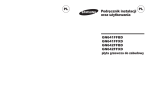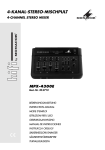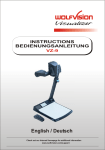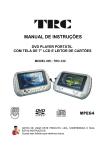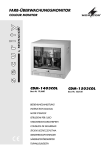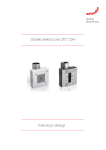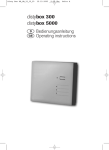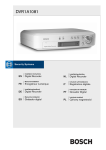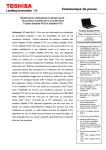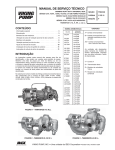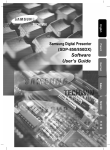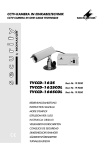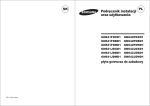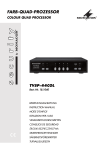Download VTM-20 - Monacor
Transcript
VIDEO-VGA-KONVERTER VIDEO VGA CONVERTER VTM-20 Best.-Nr. 19.9900 BEDIENUNGSANLEITUNG INSTRUCTION MANUAL MODE D’EMPLOI ISTRUZIONI PER L’USO MANUAL DE INSTRUCCIONES INSTRUKCJA OBSŁUGI VEILIGHEIDSVOORSCHRIFTEN SIKKERHEDSOPLYSNINGER SÄKERHETSFÖRESKRIFTER TURVALLISUUDESTA ® D A CH F B CH Bevor Sie einschalten ... GB Wir wünschen Ihnen viel Spaß mit Ihrem neuen Gerät von MONACOR. Dabei soll Ihnen diese Bedienungsanleitung helfen, alle Funktionsmöglichkeiten kennen zu lernen. Die Beachtung der Anleitung vermeidet außerdem Fehlbedienungen und schützt Sie und Ihr Gerät vor eventuellen Schäden durch unsachgemäßen Gebrauch. Der deutsche Text beginnt auf der Seite 4. Avant toute mise en service ... We wish you much pleasure with your new MONACOR unit. With these operating instructions you will be able to get to know all functions of the unit. By following these instructions false operations will be avoided, and possible damage to yourself and your unit due to improper use will be prevented. The English text starts on page 7. I Nous vous remercions d’avoir choisi un appareil MONACOR et vous souhaitons beaucoup de plaisir à l’utiliser. Cette notice a pour objectif de vous aider à mieux connaître les multiples facettes de l’appareil et à vous éviter toute mauvaise manipulation. NL B S Antes de cualquier instalación ... PL Przed Uruchomieniem ... Tenemos de agradecerle el haber adquirido un aparato MONACOR y le deseamos un agradable uso. Este manual quiere ayudarle a conocer las multiples facetas de este aparato. La observación de las instrucciones evita operaciones erróneas y protege Vd. y vuestro aparato contra todo daño posible por cualquier uso inadecuado. Życzymy zadowolenia z nowego produktu MONACOR. Dzięki tej instrukcji obsługi będą państwo w stanie poznać wszystkie funkcje tego urządzenia. Stosując się do instrukcji unikną państwo błędów i ewentualnego uszkodzenia urządzenia na skutek nieprawidłowego użytkowania. La versión española comienza en la página 16. Tekst polski zaczyna się na stronie 19. Voordat u inschakelt ... DK Wij wensen u veel plezier met uw nieuw toestel van MONACOR. Lees de veiligheidsvoorschriften, alvorens het toestel in gebruik te nemen. Door de veiligheidsvoorschriften op te volgen zal een slechte werking vermeden worden, en zal een eventueel letsel aan uzelf en schade aan uw toestel tengevolge van onzorgvuldig gebruik worden voorkomen. U vindt de veiligheidsvoorschriften op pagina 22. Förskrift Vi önskar dig mycket nöje med din nya enhet från MONACOR. Läs gärna säkerhetsinstruktionerna innan du använder enheten. Genom att följa säkerhetsistruktionerna kan många problem undvikas, vilket annars kan skada enheten. Du finner säkerhetsinstruktionerna på sidan 23. 2 Prima di accendere ... Vi auguriamo buon divertimento con il Vostro nuovo apparecchio MONACOR. Le istruzioni per l’uso Vi possono aiutare a conoscere tutte le possibili funzioni. E rispettando quanto spiegato nelle istruzioni, evitate di commettere degli errori, e così proteggete Voi stessi, ma anche l’apparecchio, da eventuali rischi per uso improprio. Il testo italiano inizia a pagina 13. La version française commence à la page 10. E Before you switch on ... Inden De tænder for apparatet ... Vi ønsker Dem god fornøjelse med Deres nye MONACOR apparat. Læs oplysningerne for en sikker brug af apparatet før ibrugtagning. Følg sikkerhedsoplysningerne for at undgå forkert betjening og for at beskytte Dem og Deres apparat mod skade på grund af forkert brug. Sikkerhedsoplysningerne finder De på side 22. FIN Ennen virran kytkemistä ... Toivomme, että uusi MONACOR-laitteesi tuo sinulle paljon iloa ja hyötyä. Ole hyvä ja lue käyttöohjeet ennen laitteen käyttöönottoa. Luettuasi käyttöohjeet voit käyttää laitetta turvallisesti ja vältyt laitteen väärinkäytöltä. Käyttöohjeet löydät sivulta 23. ☛/ Source ➀ 1 ➁ ➂ 3 Audio in C-in S-in 6 7 8 ▼/ Freq. ▲/i 2 3 4 5 9 DC 9V VGA in Monitor Line-in SPK out 10 11 12 13 14 D A Bitte klappen Sie die Seite 3 heraus. Sie sehen dann immer die beschriebenen Bedienelemente und Anschlüsse. CH 1 Bedienelemente und Anschlüsse 1.1 Oberseite (Abb. 1) 1 Taste ☛/Source schaltet zwischen den beiden Videoeingängen „C-in“ und „S-in“ um im Bildschirmmenü: zur Bestätigung einer angewählten Menüfunktion 2 Taste ▼/Freq. schaltet zwischen den beiden Bildfrequenzen 60 Hz und 75 Hz für das konvertierte Videosignal um im Bildschirmmenü: zum Anwählen der Menüfunktionen und zum Ändern von Einstellungen 3 Taste ▲/i zum Einblenden der Eigenschaften des aktuellen Videosignals im Bildschirmmenü: zum Anwählen der Menüfunktionen und zum Ändern von Einstellungen 4 Betriebsanzeige für den Videokonverter ein: konvertiertes Videosignal von „C-in“ bzw. „S-in“ und Audiosignale an „Audio-in“ werden ausgegeben aus: Signale an „VGA-in“ und „Line-in“ werden ausgegeben 5 Taste zum Aufrufen und Verlassen des Bildschirmmenüs 2 Achtung! Das Netzgerät wird mit lebensgefährlicher Netzspannung (230 V~) versorgt. Nehmen Sie deshalb nie selbst Eingriffe in dieses Gerät vor. Durch unsachgemäßes Vorgehen besteht die Gefahr eines elektrischen Schlages. Außerdem erlischt beim Öffnen des Konverters oder des Netzgerätes jeglicher Garantieanspruch. ● Setzen Sie den Konverter und das Netzgerät nur im Innenbereich ein und schützen Sie die Geräte vor Tropf- und Spritzwasser, hoher Luftfeuchtigkeit und Hitze (zulässiger Einsatztemperaturbereich 0 – 40 °C). ● Nehmen Sie den Konverter nicht in Betrieb bzw. ziehen Sie das Netzgerät sofort aus der Steckdose: 1. wenn sichtbare Schäden an dem Konverter oder am Netzgerät vorhanden sind, 2. wenn nach einem Sturz oder Ähnlichem der Verdacht auf einen Defekt besteht, 3. wenn Funktionsstörungen auftreten. Lassen Sie den Konverter oder das Netzgerät in jedem Fall in einer Fachwerkstatt reparieren. ● Verwenden Sie für die Reinigung nur ein trockenes, weiches Tuch, niemals Chemikalien oder Wasser. ● Werden der Konverter oder das Netzgerät zweckentfremdet, falsch angeschlossen bzw. bedient oder nicht fachgerecht repariert, kann keine Haftung für daraus resultierende Sach- oder Personenschäden und keine Garantie für die Geräte übernommen werden. 1.2 Vorderseite (Abb. 2) 6 Cinch-Buchsen „Audio in“ zum Anschluss des Audiosignals der Videoquelle an „C-in“ (7) oder „S in“ (8) 7 Cinch-Buchse „C-in“ zum Anschluss einer Videoquelle (z. B. Kamera, Videorecorder, DVD-Player, Spielekonsole) mit FBAS-Signal (composite) 8 Mini-DIN-Buchse „S-in“ zum Anschluss einer Videoquelle (z.B. Kamera, Videorecorder, DVDPlayer, Spielekonsole) mit S-Video-Signal 9 Taste zum Umschalten zwischen Videokonverter-Betrieb und PC-Durchschleifbetrieb (siehe Kap. 1.1, Punkt 4 „Betriebsanzeige“) 1.3 Rückseite (Abb. 3) 10 Versorgungsbuchse „DC 9V“ zum Anschluss des mitgelieferten Steckernetzgerätes 11 D-SUB-Buchse „VGA in“ zum Anschluss eines PC 12 D-SUB-Buchse „Monitor“ zum Anschluss an den Monitor 13 3,5-mm-Stereo-Klinkenbuchse „Line-in“ zum Anschluss an die Line-out-Buchse (Audioausgang) eines PC 14 3,5-mm-Stereo-Klinkenbuchse „SPK out“, Audioausgang z. B. zum Anschluss von Aktivlautsprechern 4 Hinweise für den sicheren Gebrauch Der Konverter und das beiliegende Steckernetzgerät entsprechen der Richtlinie für elektromagnetische Verträglichkeit 89/336/EWG. Das Netzgerät entspricht zusätzlich der Niederspannungsrichtlinie 73/23/EWG. Sollen der Konverter und das Netzgerät endgültig aus dem Betrieb genommen werden, übergeben Sie die Geräte zur umweltgerechten Entsorgung einem örtlichen Recyclingbetrieb. 3 Einsatzmöglichkeiten Mit diesem Konverter lassen sich Signale beliebiger Videoquellen, wie z. B. Kameras, Videomultiplexer, Videorecorder, DVD-Player oder Spielekonsolen, in ein VGA-Signal umwandeln und auf einem PC-Monitor darstellen. Das Videosignal kann im FBAS-Format (composite) oder im S-Video-Format vorliegen. Per Tastendruck lässt sich zwischen den beiden Videoeingängen umschalten. Dabei stellt sich das Gerät automatisch auf die Videonorm des anliegenden Signals (PAL oder NTSC) ein. Der Konverter besitzt zusätzlich einen VGA-Durchschleifeingang für den Anschluss eines PC sowie Audioeingänge und -ausgänge, sodass zwischen den konvertierten Videosignalen und dem VGA-Signal des PC sowie den dazugehörigen Audiosignalen umgeschaltet werden kann. Ein VGA-Kabel und ein Audiokabel für die Verbindungen vom PC zum Konverter werden mitgeliefert. Über ein Bildschirmmenü lässt sich der Konverter auf vielfältige Weise an die Bedürfnisse des Anwenders anpassen. Es lassen sich Helligkeit, Kontrast, Farbe, Bildschärfe, Auflösung, Bildfrequenz und Bildschirmtyp einstellen. 4 Anschluss Alle Anschlüsse dürfen nur bei ausgeschalteten Geräten durchgeführt werden! 1) Die Videoquelle an die Eingangsbuchse „C-in“ (7) oder „S-in“ (8) anschließen. Sind beide Eingänge mit unterschiedlichen Videoquellen belegt, kann jederzeit per Tastendruck zwischen den beiden umgeschaltet werden. 2) Den Monitor an die Buchse „Monitor“ (12) anschließen. 3) Den VGA-Ausgang des PC an die Buchse „VGA in“ (11) anschließen. 4) Den Audio-Ausgang des PC mit der Buchse „Linein“ (13) verbinden. 5) Den Audio-Ausgang der Videoquelle an die Buchsen „Audio in“ (6) anschließen. 6) Die Aktivlautsprecher des PC oder einen externen Audioverstärker an die Buchse „SPK out“ (14) anschließen. 7) Den Kleinspannungsstecker des Netzgerätes mit der Buchse „DC 9V“ (10) verbinden und das Netzgerät in eine Netzsteckdose stecken. Hinweis: Dient der VTM-20 lediglich als Konverter für das Videosignal und soll er nicht wechselweise mit einem PC an einem Monitor betrieben werden, kann auf die Anschlüsse der Punkte 3)–6) verzichtet werden. 5 Bedienung Ist die Taste (9) nicht gedrückt [die Betriebsanzeige (4) leuchtet nicht], werden die durchgeschleiften Signale an „VGA-in“ und „Line-in“ ausgegeben. Alle Einstellmöglichkeiten des Konverters haben keinerlei Einfluss auf die durchgeschleiften Signale. 1) Mit der Taste (9) den Konverter aktivieren. Die Betriebsanzeige (4) leuchtet. Es wird nun das konvertierte Videosignal auf dem Monitor dargestellt. Gleichzeitig werden die Audiosignale an den Buchsen „Audio in“ (6) auf den Ausgang „SPK out“ (14) geschaltet. 2) Zum Umschalten zwischen den beiden Videoeingängen „C-in“ (7) und „S-in“ (8) die Taste ☛/Source (1) drücken. 3) Zum Umschalten zwischen den beiden Bildfrequenzen 60 Hz und 75 Hz für die Ausgabe des Videosignals die Taste ▼/Freq. (2) drücken. 4) Mit der Taste ▲/i (3) werden für ca. 5 s Informationen zum aktuellen Videosignal eingeblendet: Videoeingang („CVBS“=“C-in“ / „S-VIDEO“=“S-in“) Videonorm (PAL / NTSC) Bildfrequenz (60 Hz / 75 Hz) Bildauflösung (1024 x 768/800 x 600/640 x 480) 5) Um die Bildeinstellungen (Helligkeit, Kontrast, Farbe usw.) durchzuführen, das Bildschirmmenü aufrufen – siehe dazu Kap. 5.1. D A CH 5.1 Einstellungen im Bildschirmmenü Mit der Taste (5) das Menü aufrufen. Mit derselben Taste kann das Menü jederzeit wieder verlassen werden. Wird bei eingeblendetem Menü länger als 15 s keine Taste gedrückt, blendet sich das Menü automatisch wieder aus. Das Menü: BRIGHTNESS Bildhelligkeit CONTRAST Kontrast COLOR Farbintensität HUE Farbton SHARPNESS Bildschärfe RESOLUTION Bildauflösung FREQUENCY Bildfrequenz MONITOR Monitortyp RESET Rücksetzen aller Einstellungen Die gewünschte Menüfunktion mit den Tasten ▼/Freq. (2) oder ▲/i (3) anwählen und mit der Taste ☛/Source (1) bestätigen. Die angewählte Funktion ist rot markiert. Anschließend die Einstellung mit den Pfeiltasten (2 oder 3) vornehmen. 1) Zum Einstellen von Bildhelligkeit (BRIGHTNESS), Kontrast (CONTRAST), Farbintensität (COLOR), Farbton (HUE) und Bildschärfe (SHARPNESS) die jeweilige Funktion aufrufen (mit den Pfeiltasten ▲ und ▼ anwählen und mit ☛ bestätigen) und anschließend mit den Pfeiltasten den gewünschten Wert (min. 0 bis max. 100, bei SHARPNESS: 0 bis 15) einstellen: Zum Erhöhen des Wertes die Taste ▲/i (3) drücken, zum Reduzieren des Wertes die Taste ▼/Freq. (2). 2) Für eine Änderung der Bildauflösung (horizontale und vertikale Anzahl der Bildpunkte im konvertierten Videosignal) die Funktion RESOLUTION aufrufen. Mit den Tasten ▲/i (3) und ▼/Freq. (2) kann zwischen den folgenden Auflösungen gewählt werden: 1024 x 768, 800 x 600 und 640 x 480. Der aktuelle Wert ist farbig unterlegt dargestellt. 3) Über die Funktion FREQUENCY kann, wie mit der Taste ▼/Freq. (2) außerhalb des Menüs, zwischen den beiden Bildfrequenzen 60 Hz und 75 Hz für die Ausgabe des Videosignals umgeschaltet werden. Dazu die Taste ▲/i (3) oder ▼/Freq. (2) drücken. Der aktuelle Wert ist farbig unterlegt dargestellt. 4) Über die Funktion MONITOR kann der Typ des verwendeten Monitors gewählt werden. Zur Auswahl stehen LCD (Flüssigkeitskristallanzeige) und CRT (Kathodenstrahlröhre). Mit der Taste ▲/i (3) oder ▼/Freq. (2) den zutreffenden Monitortyp auswählen. Der aktuell eingestellte Typ ist farbig unterlegt dargestellt. 5) Über die Funktion SOURCE kann, wie mit der Taste ☛/Source (1) außerhalb des Menüs, zwischen den beiden Videoeingängen „CVBS“=„C-in“ (7) und „S-VIDEO“=„S-in“ (8) umgeschaltet werden. 5 D A CH Dazu die Taste ▲/i (3) oder ▼/Freq. (2) drücken. Der gewählte Eingang ist farbig unterlegt dargestellt. 6) Für das Zurücksetzen der Menüeinstellungen die Funktion RESET anwählen und mit der Taste ☛/Source (1) bestätigen. Diese Funktion löscht alle vom Anwender vorgenommenen Einstellungen und ersetzt sie durch die Werkseinstellung. 5.2 Nach dem Gebrauch Da das Gerät auch im Durchschleifbetrieb einen geringen Strom verbraucht, ist es ratsam, nach dem Gebrauch das Netzgerät aus der Steckdose zu ziehen. 6 Technische Daten Videonormen: . . . . PAL, NTSC Auflösungen (Bildpunkte hor. x vert.):. . . . . . 1024 x 768 800 x 600 640 x 480 Bildfrequenzen:. . . 60 Hz, 75 Hz Videoeingänge:. . . Cinch, FBAS (composite) Mini-DIN, S-Video D-SUB, 15-pol., VGA Audioeingänge:. . . Cinch, stereo 3,5-mm-Klinke, stereo Videoausgang: . . . D-SUB, 15-pol., VGA Audioausgang: . . . 3,5-mm-Klinke, stereo Einsatztemperatur: 0 – 40 °C Stromversorgung: . 9 V , 600 mA über beiliegendes Netzgerät an 230 V~/50 Hz/5 VA Abmessungen: . . . 170 x 30 x 110 mm Gewicht: . . . . . . . . 225 g Laut Angaben des Herstellers. Änderungen vorbehalten. Diese Bedienungsanleitung ist urheberrechtlich für MONACOR ® INTERNATIONAL GmbH & Co. KG geschützt. Eine Reproduktion für eigene kommerzielle Zwecke – auch auszugsweise – ist untersagt. 6 Please unfold page 3. Then you can always see the operating elements and connections described. 1 Operating Elements and Connections 1.1 Upper side (fig. 1) 1 Button ☛/Source to switch between the two video inputs “C-in” and “S-in”. in the on-screen menu: to confirm a selected menu function 2 Button ▼/Freq. to switch between the two picture frequencies 60 Hz and 75 Hz for the converted video signal in the on-screen menu: to select the menu functions and to change adjustments 3 Button ▲/i to insert the features of the present video signal in the on-screen menu: to select the menu functions and to change adjustments 4 Power LED for the video converter on: converted video signal from “C-in” or “S-in” and audio signals at “Audio-in” are sent to the output off: signals at “VGA-in” and “Line-in” are sent to the output 5 Button to call and exit the on-screen menu 2 ● ● ● ● 1.3 Rear side (fig. 3) 10 Supply jack “DC 9V” for connection of the supplied plug-in power supply unit 11 D-SUB jack “VGA in” for connection of a PC 12 D-SUB jack “Monitor” for connection to the monitor 13 3.5 mm stereo jack “Line-in” for connection to the line-out jack (audio output) of a PC 14 3.5 mm stereo jack “SPK out”, audio output e. g. for connection of active speakers GB Attention! The power supply unit is supplied with hazardous mains voltage (230 V~). Leave servicing to skilled personnel only. Inexpert handling may cause an electric shock hazard. Furthermore, any guarantee claim will expire if the converter or the power supply unit has been opened. 1.2 Front side (fig. 2) 6 Phono jacks “Audio in” for connection of the audio signal of the video source at “C-in” (7) or “S-in” (8) 7 Phono jack “C-in” for connection of a video source (e. g. camera, video recorder, DVD player, games console) with composite signal 8 Mini DIN jack “S-in” for connection of a video source (e. g. camera, video recorder, DVD player, games console) with S-video signal 9 Button for switching between video converter operation and PC feed-through operation (see chapter 1.1, item 4 “Power LED”) Safety Notes The converter and the supplied plug-in power supply unit correspond to the directive 89/336/EEC for electromagnetic compatibility. The power supply unit additionally corresponds to the low voltage directive 73/23/EEC. The converter and the power supply unit are suitable for indoor use only. Protect them against dripping water and splash water, high air humidity, and heat (admissible ambient temperature range 0–40 °C). Do not set the converter into operation, and immediately disconnect the power supply unit from the mains socket if 1. there is visible damage to the converter or the power supply unit, 2. a defect might have occurred after a drop or similar accident, 3. there are malfunctions. The converter and the power supply unit must in any case be repaired by skilled personnel. For cleaning only use a dry, soft cloth, by no means chemicals or water. No guarantee claims for the converter or the power supply unit and no liability for any resulting personal damage or material damage will be accepted if the units are used for other purposes than originally intended, if they are not correctly connected, operated, or not repaired in an expert way. If the converter and the power supply unit are to be put out of operation definitively, take them to a local recycling plant for a disposal which is not harmful to the environment. 3 Applications This converter allows to convert signals of any desired video sources, e. g. cameras, video multiplexers, video recorders, DVD players, or games consoles, into a VGA signal and to display them on a PC monitor. The video signal can be available in the composite format or in the S-video format. By pressing a button it is possible to switch between both video inputs. Then the unit automatically adjusts itself to the video standard of the applied signal (PAL or NTSC). The converter additionally has a VGA feed-through input for the connection of a PC and audio inputs and audio outputs so that it is possible to switch between the converted video signals and the VGA signal of the PC and the corresponding audio signals. A VGA cable and an audio cable for the connections from the PC to the converter are supplied. 7 GB Via an on-screen menu the converter can be adapted to the requirements of the user in a versatile way. It is possible to adjust brightness, contrast, colour, picture sharpness, resolution, picture frequency, and monitor type. 4 Connection All connections must only be made with the units switched off! 1) Connect the video source to the input jack “C-in” (7) or “S-in” (8). If different video sources are connected to the two inputs, it is possible to switch between them at any time by pressing a button. 2) Connect the monitor to the jack “Monitor” (12). 3) Connect the VGA output of the PC to the jack “VGA in” (11). 4) Connect the audio output of the PC to the jack “Line-in” (13). 5) Connect the audio output of the video source to the jacks “Audio in” (6). 6) Connect the active speaker of the PC or an external audio amplifier to the jack “SPK out” (14). 7) Connect the low voltage plug of the power supply unit to the jack “DC 9V” (10) and the power supply unit to a mains socket. Note: If the VTM-20 only serves as a converter for the video signal and if it is not to be operated alternately with a PC at a monitor, the connections of items 3) to 6) are not necessary. 5 Operation If the button (9) is not pressed [the operating indication (4) does not light up], the fed-through signals at “VGA in” and “Line-in” are sent to the output. Any adjusting possibilities of the converter will not have any effect on the fed-through signals. 1) Activate the converter with the button (9). The power LED (4) lights up. Now the converted video signal is displayed on the monitor. At the same time the audio signals at the jacks “Audio in” (6) are sent to the output “SPK out” (14). 2) To switch between the two video inputs “C-in” (7) and “S-in” (8), press the button ☛/Source (1). 3) To switch between the two picture frequencies 60 Hz and 75 Hz for the output of the video signal, press the button ▼/Freq. (2). 4) With the button ▲/i (3) information on the present video signal is inserted for approx. 5 s: video input (“CVBS” = “C-in”/“S-VIDEO” = “S-in”) video standard (PAL/NTSC) picture frequency (60 Hz/75 Hz) picture resolution (1024 x 768/800x600/640x480) 5) To make the picture adjustments (brightness, contrast, colour, etc.), call the on-screen menu – for this purpose see chapter 5.1. 8 5.1 Adjustments in the on-screen menu Call the menu with the button (5). With the same button the menu can be exited at any time. If no button is pressed for more than 15 s with the menu inserted, the menu will be automatically extinguished. The menu: BRIGHTNESS CONTRAST COLOR HUE SHARPNESS RESOLUTION FREQUENCY MONITOR RESET Select the desired menu function with the buttons ▼/Freq. (2) or ▲/i (3) and confirm with the button ☛/Source (1). The selected function has a red marking. Then make the adjustment with the arrow keys (2 or 3). 1) To adjust the BRIGHTNESS, CONTRAST, COLOR intensity, HUE, and the picture SHARPNESS, call the respective function (select it with the arrow keys ▲ and ▼ and confirm with ☛) and then adjust the desired value (min. 0 to max. 100, for SHARPNESS: 0 to 15) with the arrow keys: to increase the value, press the button ▲/i (3), to decrease the value, the button ▼/Freq. (2). 2) For a change of the picture resolution (horizontal and vertical number of the pixels in the converted video signal), call the function RESOLUTION. With the buttons ▲/i (3) and ▼/Freq. (2) it is possible to select between the following resolutions: 1024 x 768, 800 x 600, and 640 x 480. The present value is highlighted in colour. 3) Via the function FREQUENCY it is possible to switch between the two picture frequencies 60 Hz and 75 Hz for the output of the video signal. The same is possible with the button ▼/Freq. (2) outside the menu. For this purpose press the button ▲/i (3) or ▼/Freq. (2). The present value is highlighted in colour. 4) Via the function MONITOR the type of the monitor used can be selected. LCD (liquid crystal display) and CRT (cathode ray tube) are available for selection. With the button ▲/i (3) or ▼/Freq. (2) select the corresponding monitor type. The type currently adjusted is highlighted in colour. 5) Via the function SOURCE it is possible to switch between the two video inputs “CVBS” = “C-in” (7) and “S-VIDEO” = “S-in” (8). The same is possible with the button ☛/Source (1) outside the menu. For this purpose press the button ▲/i (3) or ▼/Freq. (2). The selected input is highlighted in colour. 6) To reset the menu adjustments, select the function RESET and confirm with the button ☛/Source (1). This function deletes all adjustments made by the user and replaces them by the factory settings. GB 5.2 After use As the unit has a low current consumption even in the feed-through operation, it is recommended to disconnect the power supply unit from the mains socket after use. 6 Specifications Video standards:. . PAL, NTSC Resolutions (pixels hor. x vert.): 1024 x 768 800 x 600 640 x 480 Picture frequencies: 60 Hz, 75 Hz Video inputs: . . . . . phono, composite mini DIN, S-video D-SUB, 15-pole, VGA Audio inputs: . . . . . phono, stereo 3.5 mm jack, stereo Video output:. . . . . D-SUB, 15-pole, VGA Audio output:. . . . . 3.5 mm jack, stereo Ambient temperature: . . . . . 0 – 40 °C Power supply: . . . . 9 V , 600 mA via supplied power supply unit connected to 230 V~/50 Hz/5 VA Dimensions: . . . . . 170 x 30 x 110 mm Weight: . . . . . . . . . 225 g According to the manufacturer. Subject to technical modification. All rights reserved by MONACOR ® INTERNATIONAL GmbH & Co. KG. No part of this instruction manual may be reproduced in any form or by any means for any commercial use. 9 F B Ouvrez le présent livret page 3 de manière à visualiser les éléments et branchements. CH 1 Eléments et branchements 1.1 Face supérieure (schéma 1) 1 Touche ☛/Source : commute entre les deux entrées vidéo “C-in” et “S-in” Sur le menu écran : pour confirmer une fonction du menu sélectionné 2 Touche ▼/Freq. : commute entre les deux fréquences d’images 60 Hz et 75 Hz pour le signal vidéo converti Sur le menu écran : pour sélectionner les fonctions du menu et pour modifier les réglages 3 Touche ▲/i pour afficher les propriétés du signal vidéo actuel Sur le menu écran : pour sélectionner les fonctions du menu et pour modifier les réglages 4 Témoin de fonctionnement pour le convertisseur vidéo marche : le signal vidéo converti de “C-in” ou “S-in” et les signaux audio à “Audio-in” sont envoyés à la sortie arrêt : les signaux à “VGA-in” et “Line-in” sont envoyés à la sortie 5 Touche pour appeler et quitter le menu écran 2 Attention ! Le bloc secteur est alimenté par une tension dangereuse 230 V~. Ne touchez jamais l’intérieur de l’appareil car, en cas de mauvaise manipulation, vous pourriez subir une décharge électrique mortelle. En outre, l’ouverture de l’appareil ou du bloc secteur rend tout droit à la garantie caduque. ● ● ● ● 1.2 Face avant (schéma 2) 6 Prises RCA “Audio in” pour brancher le signal audio de la source vidéo à “C-in” (7) ou “S-in” (8) 7 Prise RCA “C-in” pour brancher une source vidéo (p. ex. caméra, magnétoscope, lecteur DVD, console de jeu) avec signal composite 8 Mini prise DIN “S-in” pour brancher une source vidéo (par exemple caméra, magnétoscope, lecteur DVD, console de jeu) avec signal S-VHS 9 Touche pour commuter entre fonctionnement convertisseur vidéo et fonctionnement repiquage PC (voir chapitre 1.1, point 4 “témoin de fonctionnement”) 1.3 Face arrière (schéma 3) 10 Prise d’alimentation “DC 9V” pour brancher le bloc secteur livré 11 Prise D-SUB “VGA in” pour brancher un PC 12 Prise D-SUB “Monitor” pour brancher au moniteur 13 Prise jack 3,5 stéréo “Line-in” pour brancher à la prise Line out (sortie audio) d’un PC 14 Prise jack 3,5 stéréo “SPK out “, sortie audio par exemple pour brancher des haut-parleurs actifs 10 Conseils d’utilisation et de sécurité Le convertisseur et le bloc secteur livré répondent à la norme européenne 89/336/CEE relative à la compatibilité électromagnétique ; le bloc secteur répond en plus à la norme européenne 73/23/CEE portant sur les appareils à basse tension. Ne faites fonctionner le convertisseur et le bloc secteur qu’en intérieur et protégez-les de tout type de projections d’eau, des éclaboussures, d’une humidité élevée et la chaleur (plage de température de fonctionnement autorisée : 0 – 40 °C). Ne faites pas fonctionner le convertisseur ou débranchez immédiatement le bloc secteur du secteur lorsque : 1. des dommages apparaissent sur le convertisseur ou le bloc secteur 2. après une chute ou un cas similaire, vous avez un doute sur l’état de l’appareil, 3. des dysfonctionnements apparaissent. Faites toujours appel à un technicien spécialisé pour effectuer les réparations. Pour le nettoyage, utilisez un chiffon sec et doux, en aucun cas, de produits chimiques ou d’eau. Nous déclinons toute responsabilité en cas de dommages matériels ou corporels résultants si le convertisseur ou le bloc secteur est utilisé dans un but autre que celui pour lequel il a été conçu, s’il n’est pas correctement branché, utilisé ou n’est pas réparé par une personne habilitée, en outre, la garantie deviendrait caduque. Lorsque le convertisseur et le bloc secteur sont définitivement retirés du service, vous devez les déposer dans une usine de recyclage adaptée pour contribuer à leur élimination non polluante. 3 Possibilités d’utilisation Avec ce convertisseur, on peut convertir des signaux de sources vidéo au choix, p. ex. caméras, multiplexeurs vidéo, enregistreurs vidéo, lecteurs DVD, consoles de jeu, en un signal VGA et les afficher sur un moniteur de PC. Le signal vidéo peut être au format composite ou au format S-VHS. Par pression sur la touche, on peut commuter entre les deux entrées vidéo. L’appareil se règle automatiquement sur la norme vidéo du signal présent (PAL ou NTSC). Le convertisseur possède, en plus, une entrée VGA pour repiquage pour brancher un PC et des entrées et sorties audio de sorte qu’on puisse commuter entre les signaux vidéo convertis et le signal VGA du PC et entre les signaux audio correspondants. Un cordon VGA et un cordon audio pour les liaisons du PC au convertisseur sont livrés. Via le menu écran, le convertisseur peut être adapté de multiples façons aux besoins de l’utilisateur. On peut régler la luminosité, le contraste, la couleur, la netteté de l’image, la résolution, la fréquence d’image et le type d’écran. 4 Branchement Il faut effectuer les branchements exclusivement si les appareils sont éteints! 1) Reliez la source vidéo à la prise d’entrée “C-in” (7) ou “S-in” (8). Si des sources vidéo différentes sont reliées aux deux entrées, on peut à tout moment commuter entre les deux par une pression sur la touche. 2) Reliez le moniteur à la prise “Monitor” (12). 3) Reliez la sortie VGA du PC à la prise “VGA in” (11). 4) Reliez la sortie audio du PC à la prise “Line-in” (13). 5) Reliez la sortie audio de la source vidéo aux prises “Audio in” (6). 6) Reliez les haut-parleurs actifs du PC ou un amplificateur audio externe à la prise “SPK out” (14). 7) Connectez la fiche d’alimentation du bloc secteur à la prise “DC 9 V” (10) puis reliez le bloc secteur à une prise secteur. Conseil : si le VTM-20 ne sert que de convertisseur pour le signal vidéo et s’il ne devait pas fonctionner alternativement avec un PC relié à un moniteur, on peut s’affranchir des points 3) à 6). 5 Utilisation Si la touche (9) n’est pas enfoncée [le témoin de fonctionnement (4) ne brille pas], les signaux repiqués à “VGA-in” et “Line-in” sont envoyés vers la sortie. Toutes les possibilités de réglage du convertisseur n’ont aucune influence sur les signaux repiqués. 1) Avec la touche (9), activez le convertisseur. La LED (4) brille. Le signal vidéo converti est affiché sur le moniteur. Simultanément, les signaux audio aux prises “Audio in” (6) sont envoyés sur la sortie “SPK out” (14). 2) Pour commuter entre les deux entrées vidéo “C-in” (7) et “S-in” (8), enfoncez la touche ☛/Source (1). 3) Pour commuter entre les deux fréquences d’images 60 Hz et 75 Hz pour la sortie du signal vidéo, enfoncez la touche ▼/Freq. (2). 4) Avec la touche ▲/i (3), les informations sur le signal vidéo actuel sont affichées pendant 5 secondes environ : entrée vidéo (“CVBS”=“C-in”/“S-VIDEO”=“S-in”) norme vidéo (PAL/NTSC) Fréquence images (60 Hz/75 Hz) Résolution image (1024 x 768/800x600/640x480) 5) Pour effectuer les réglages d’image (luminosité, contraste, couleur …), appelez le menu écran (voir chapitre 5.1). 5.1 Réglages sur le menu écran Avec la touche (5), appelez le menu. Avec la même touche, vous pouvez quitter à tout moment le menu. Si lorsque le menu est affiché, aucune touche n’est enfoncée pendant plus de 15 secondes, le menu disparaît automatiquement. Le menu : BRIGHTNESS luminosité image CONTRAST contraste COLOR intensité couleur HUE chromaticité SHARPNESS netteté image RESOLUTION résolution image FREQUENCY fréquence image MONITOR type moniteur RESET réinitialisation de tous les réglages F B CH Sélectionnez la fonction de menu voulue avec les touches ▼/Freq. (2) ou ▲/i (3) et confirmez avec la touche ☛/Source (1). La fonction sélectionnée est repérée en rouge. Ensuite, effectuez le réglage avec les touches flèche (2 ou 3). 1) Pour régler la luminosité de l’image (BRIGHTNESS), le contraste (CONTRAST), l’intensité des couleurs (COLOR), la chromaticité (HUE) et la netteté de l’image (SHARPNESS), appelez la fonction correspondante (sélectionnez avec les touches flèche ▲ et ▼ et confirmez avec ☛), puis avec les touches flèche, réglez la valeur voulue (minimum 0 à maximum 100, pour SHARPNESS : de 0 à 15) : pour augmenter la valeur, enfoncez la touche ▲/i (3), pour diminuer la valeur, enfoncez la touche ▼/Freq. (2). 2) Pour modifier la résolution de l’image (nombre vertical et horizontal de points de l’image dans le signal vidéo converti), appelez la fonction RESOLUTION. Avec les touches ▲/i (3) et ▼/Freq. (2), on peut choisir entre les résolutions suivantes : 1024 x 768, 800 x 600 et 640 x 480. La valeur actuelle est repérée en couleur. 3) Via la fonction FREQUENCY, on peut basculer entre les deux fréquences d’image 60 Hz et 75 Hz pour la sortie du signal vidéo comme avec la touche ▼/Freq. (2) en dehors du menu. Pour ce faire, enfoncez la touche ▲/i (3) ou ▼/Freq. (2). La valeur actuelle est soulignée en couleur. 4) Via la fonction MONITOR, on peut sélectionner le type de moniteur utilisé. Deux types sont disponibles : LCD (affichage à cristaux liquides) et CRT (tubes cathodiques). Avec la touche ▲/i (3) ou ▼/Freq. (2), sélectionnez le type de moniteur concerné. Le type sélectionné est repéré en couleur. 5) Via la fonction SOURCE, on peut commuter entre les deux entrées vidéo “CVBS”=“C-in” (7) et “SVIDEO”=“S-in” (8) ; la même chose est possible avec la touche ☛/Source (1) en dehors du menu. Pour ce faire, enfoncez la touche ▲/i(3) ou ▼/Freq. (2), l’entrée sélectionnée est repérée en couleur. 11 F B CH 6) Pour réinitialiser les réglages du menu, sélectionnez la fonction RESET et confirmez avec la touche ☛/Source (1). Cette fonction efface l’ensemble des réglages effectués par l’utilisateur et les remplace par les réglages d’usine. 5.2 Après l’utilisation Dans la mesure où l’appareil a une faible consommation même en mode pour repiquage, il est conseillé de débrancher le bloc secteur de la prise secteur après l’utilisation. 6 Caractéristiques techniques Normes vidéo : . . . PAL, NTSC Résolutions (points image hor. x vert.) : . . . . . 1024 x 768 800 x 600 640 x 480 Fréquences image : . . . . . . . . . 60 Hz, 75 Hz Entrées vidéo : . . . RCA, composite Mini DIN, S-VHS D-SUB, 15 pôles, VGA Entrées audio : . . . RCA, stéréo jack 3,5 stéréo Sortie vidéo :. . . . . D-SUB, 15 pôles, VGA Sortie audio :. . . . . jack 3,5 stéréo Température fonc. : 0 – 40 °C Alimentation : . . . . 9 V , 600 mA par bloc secteur livré relié à 230 V~/50 Hz/5 VA Dimensions : . . . . . 170 x 30 x 110 mm Poids :. . . . . . . . . . 225 g D’après les données du constructeur. Tout droit de modification réservé. Notice d’utilisation protégée par le copyright de MONACOR ® INTERNATIONAL GmbH & Co. KG. Toute reproduction même partielle à des fins commerciales est interdite. 12 Vi preghiamo di aprire completamente la pagina 3. Così vedrete sempre gli elementi di comando e i collegamenti descritti. 1 Elementi di commando e collegamenti 1.1 Lato superiore (fig. 1) 1 Tasto ☛/Source cambia fra i due ingressi video “C-in” e “S-in” nel menù sullo schermo: per confermare la funzione selezionata del menù 2 Tasto ▼/Freq. cambia fra le due frequenze per l’immagine, 60 Hz e 75 Hz, per il segnale video convertito nel menù sullo schermo: per selezionare la funzione del menu e per cambiare le impostazioni 3 Tasto ▲/i visualizza le caratteristiche del segnale video attuale nel menù sullo schermo: per selezionare la funzione del menu e per cambiare le impostazioni 4 Spia di funzionamento del convertitore video on: vengono emessi il segnale video convertito di “C-in” o “S-in” e i segnali audio di “Audio-in” off: vengono emessi i segnali di “VGA-in” e “Line-in” 5 Tasto per chiamare ed abbandonare il menù sullo schermo 2 1.3 Lato posteriore (fig. 3) 10 Presa di alimentazione “DC 9V” per collegare l’alimentatore in dotazione 11 Presa D-SUB “VGA in” per collegare un PC 12 Presa D-SUB “Monitor” per collegare il monitor 13 Jack stereo 3,5 mm “Line-in” per il collegamento con la presa Line out (uscita audio) di un PC 14 Jack stereo 3,5 mm “SPK out”, uscita audio, p. es. per collegare altoparlanti attivi I Attenzione! L’alimentatore funziona con tensione di rete di 230 V~. Non intervenire mai al suo interno; la manipolazione scorretta può provocare delle scariche pericolose. Se il convertitore o l’alimentatore vengono aperti, cessa ogni diritto di garanzia. ● ● ● ● 1.2 Lato anteriore (fig. 2) 6 Prese RCA “Audio in” per collegare il segnale audio della sorgente video con “C-in” (7) o “S-in” (8) 7 Presa RCA “C-in” per collegare una sorgente video (p. es. videocamera, videoregistratore, lettore DVD, console di giochi) con segnale composito 8 Presa mini-DIN “S-in”per collegare una sorgente video (p. es. videocamera, videoregistratore, lettore DVD, console di giochi) con segnale S-Video 9 Tasto per cambiare fra funzionamento come convertitore video e funzionamento di attraversamento PC (vedi cap. 1.1, punto 4 “Spia di funzionamento”) Avvertenze di sicurezza Il convertitore e l’alimentatore in dotazione sono conformi alla direttiva CE 89/336/CEE sulla compatibilità elettromagnetica. L’alimentatore è in più conforme alla direttiva 73/23/CEE per apparecchi a bassa tensione. Far funzionare il convertitore e l’alimentatore solo all’interno di locali e proteggeteli dall’acqua gocciolante e dagli spruzzi d’acqua, da alta umidità dell’aria e dal calore (temperatura d’impiego ammessa fra 0 e 40 °C). Non mettere in funzione i convertitore o staccare subito l’alimentatore dalla rete se: 1. il convertitore o l’alimentatore presentano dei danni visibili; 2. dopo una caduta o dopo eventi simili sussiste il sospetto di un difetto; 3. l’apparecchio non funziona correttamente. Per la riparazione del convertitore o dell’alimentatore rivolgersi sempre ad un’officina competente. Per la pulizia usare solo un panno morbido, asciutto; non impiegare in nessun caso prodotti chimici o acqua. Nel caso d’uso improprio, di collegamenti o impieghi sbagliati o di riparazione non a regola d’arte del convertitore o dell’alimentatore, non si assume nessuna responsabilità per eventuali danni consequenziali a persone o a cose e non si assume nessuna garanzia per lo strumento. Se si desidera eliminare il convertitore e l’alimentatore definitivamente, consegnarli per lo smaltimento ad un’istituzione locale per il riciclaggio. 3 Possibilità d’impiego Con questo convertitore è possibile convertire i segnali di qualsiasi sorgente video, p. es. di telecamere, multiplexer video, videoregistratori, lettori DVD o console di giochi, in un segnale VGA e riprodurlo su un monitor per PC. Il segnale video può essere un segnale composito oppure un segnale S-Video. Con la pressione di un tasto si cambia fra i due ingressi video. L’apparecchio imposta automaticamente la norma video del segnale presente (PAL o NTSC). Il convertitore possiede in più un ingresso VGA di attraversamento per il collegamento di un PC nonché ingressi ed uscite audio in modo da poter cambiare fra i segnali video convertiti e il segnale VGA del PC nonché fra i relative segnali audio. Sono in dotazione un cavo VGA e un cavo audio per il collegamento fra PC e convertitore. Tramite il menù sullo schermo, il convertitore può essere adattato in tanti modo alle esigenze dell’utente. Si possono impostare luminosità, contrasto, fuoco, risoluzione, frequenza dell’immagine e tipo di schermo. 13 I 4 Collegamento Tutti i collegamenti devono essere eseguiti solo con gli apparecchi spenti! 1) Collegare la sorgente video con la presa d’ingresso “C-in” (7) o “S-in” (8). Se entrambi gli ingressi sono impegnati con sorgenti video differenti, con la pressione di un tasto si può cambiare in ogni momento fra i due ingressi. 2) Collegare il monitor con la presa “Monitor” (12). 3) Collegare l’uscita VGA del PC con la presa “VGA in” (11). 4) Collegare l’uscita audio del PC con la presa “Linein” (13). 5) Collegare l’uscita audio della sorgente video con le prese “Audio in” (6). 6) Collegare gli altoparlanti attivi del PC oppure un amplificatore audio esterno con la presa “SPK out” (14). 7) Collegare la spina di alimentazione DC dell’alimentatore con la presa “DC 9V” (10) e inserire l’alimentatore in un presa di rete. N. B.: Se il VTM-20 serve solo come convertitore per il segnale video e se non è richiesto il funzionamento alternativo con un monitor e tramite un PC, si può fare a meno dei collegamenti dei punti 3) – 6). 5 Funzionamento Se il tasto (9) non è premuto [la spia di funzionamento (4) non è accesa], vengono emessi i segnali di attraversamento presenti a “VGA-in” e “Line-in”. Tutte le possibilità di impostazione del convertitore sono senza importanza per i segnali di attraversamento. 1) Attivare il convertitore con il tasto (9). La spia di funzionamento (4) si accende. Sul monitor si vede il segnale video convertito. Nello stesso tempo, i segnali audio delle prese “Audio in” (6) vengono portati sull’uscita “SPK out” (14). 2) Per cambiare fra i due ingressi video “C-in” (7) e “S-in” (8) premere il tasto ☛/Source (1). 3) Per cambiare fra le due frequenze dell’immagine 60 Hz e 75 Hz per l’emissione del segnale video, premere il tasto ▼/Freq. (2). 4) Con il tasto ▲/i (3) saranno visualizzate per 5 sec. circa delle informazioni sul segnale video attuale: ingresso video (“CVBS”=“C-in”/“S-VIDEO”=“S-in”) norma video (PAL/NTSC) frequenza immagine (60 Hz/75 Hz) risoluzione (1024 x 768/800 x 600/640 x 480) 5) Per eseguire le impostazioni per l’immagine (luminosità, contrasto, colore ecc.), chiamare il menù sullo schermo – vedi cap. 5.1. 14 5.1 Impostazioni con il menù sullo schermo Chiamare il menu con il tasto (5). Con lo stesso tasto si può uscire dal menu in qualsiasi momento. Se con il menù presente, per più di 15 sec. non si preme nessun tasto, il menù si spegne automaticamente. Il menù: BRIGHTNESS luminosità dell’immagine CONTRAST contrasto COLOR saturazione dei colori HUE tono cromatico SHARPNESS fuoco RESOLUTION risoluzione FREQUENCY frequenza dell’immagine MONITOR tipo del monitor RESET reset di tutte le impostazioni Selezionare la funzione richiesta del menu con i tasti ▼/Freq. (2) o ▲/i (3) e confermare con il tasto ☛/Source (1). La funzione selezionata è evidenziata in rosso. Quindi eseguire le impostazioni con l’aiuto dei tasti freccia (2 o 3). 1) Per impostare luminosità (BRIGHTNESS), contrasto (CONTRAST), saturazione (COLOR), tono cromatico (HUE) e fuoco (SHARPNESS), chiamare la relativa funzione (selezionarla con i tasti freccia ▲ e ▼ e confermare con ☛) e successivamente impostare il valore desiderato (min. 0 fino a max. 100, con SHARPNESS: 0 a 15), aiutandosi con i tasti freccia: per aumentare il valore premere il tasto ▲/i (3), per ridurre il valore usare il tasto ▼/Freq. (2). 2) Per modificare la risoluzione (numero dei pixel orizzontali e verticali nel segnale video convertito), chiamare la funzione RESOLUTION. Con i tasti ▲/i (3) e ▼/Freq. (2) si può scegliere fra le seguenti risoluzioni: 1024 x 768, 800 x 600 e 640 x 480. Il valore attuale è evidenziato con un colore. 3) Tramite la funzione FREQUENCY è possibile, come con il tasto ▼/Freq. (2) al di fuori del menù, cambiare fra le due frequenze per l’immagine, 60 Hz e 75 Hz, valide per la rappresentazione del segnale video. Premere il tasto ▲/i (3) o ▼/Freq. (2). Il valore attuale è evidenziato con un colore. 4) Tramite la funzione MONITOR è possibile scegliere il tipo del monitor usato. Si può scegliere fra LCD (a cristalli liquidi) e CRT (tubo catodico). Premere il tasto ▲/i (3) o ▼/Freq. (2) per selezionare il monitor. Il tipo impostato è evidenziato con un colore. 5) Tramite la funzione SOURCE si può, come con il tasto ☛/Source (1) al di fuori del menù, cambiare fra i due ingressi video “CVBS”=“C-in” (7) e “S-VIDEO”=“S-in” (8). Premere il tasto ▲/i (3) o ▼/Freq. (2). L’ingresso selezionato è evidenziato con un colore. 6) Per resettare le impostazioni del menu, selezionare la funzione RESET e confermare con il tasto ☛/Source (1). Questa funzione cancella tutte le impostazioni eseguite dall’utente e le sostituisce con le impostazioni dalla fabbrica. I 5.2 Dopo l’uso Dato che l’apparecchio consuma un po’ di corrente anche nel funzionamento di attraversamento, è consigliabile, dopo l’uso, staccare l’alimentatore dalla presa di rete. 6 Dati tecnici Norme video: . . . . PAL, NTSC Risoluzione (pixel orizz. x vert.): 1024 x 768 800 x 600 640 x 480 Frequenze immagine: . . . . . . . 60 Hz, 75 Hz Ingressi video:. . . . RCA, composito Mini-DIN, S-Video D-SUB, 15 poli, VGA Ingressi audio: . . . RCA, stereo jack 3,5 mm, stereo Uscita video: . . . . . D-SUB, 15 poli, VGA Uscita audio: . . . . . jack 3,5 mm, stereo Temperatura d’esercizio: . . . . . . 0 – 40 °C. Alimentazione: . . . 9 V , 600 mA tramite alimentatore in dotazione con 230 V~/50 Hz/5 VA Dimensioni: . . . . . . 170 x 30 x 110 mm Peso:. . . . . . . . . . . 225 g Dati forniti dal costruttore. Con riserva di modifiche tecniche. La MONACOR ® INTERNATIONAL GmbH & Co. KG si riserva ogni diritto di elaborazione in qualsiasi forma delle presenti istruzioni per l’uso. La riproduzione – anche parziale – per propri scopi commerciali è vietata. 15 E Abrir el presente libro página 3 de manera a visualizar los elementos y las conexiones. 1 Elementos operativos y conexiones 1.1 Parte superior (fig. 1) 1 Botón ☛/Source para conmutar entre dos entradas vídeo “C-in” y “S-in”. en el menú de pantalla: para confirmar una función del menú seleccionada 2 Botón ▼/Freq. para conmutar entre dos frecuencias de imagen 60 Hz y 75 Hz para la señal vídeo convertida en el menú de pantalla: para seleccionar las funciones del menú y cambiar ajustes 3 Botón ▲/i para insertar las características de la señal vídeo actual en el menú pantalla: para seleccionar las funciones de menú y cambiar ajustes 4 LED de potencia para el conversor vídeo on: señal vídeo convertida desde “C-in” o “S-in” y señales audio en “Audio-in” se envían a la salida off: señales en “VGA-in y “Line-in” se envían a la salida 5 Botón para llamar y salir del menú de pantalla 2 ¡Atención! La unidad de alimentación recibe un voltaje principal peligroso de 230 V~. No manipule nunca el interior del aparato, podría en caso de manipulación inadecuada, sufrir una descarga eléctrica mortal. La apertura del conversor o de la unidad de alimentación niega todo derecho de garantía. ● ● ● 1.2 Parte delantera (fig. 2) 6 Tomas phono “Audio in” para la conexión de la señal audio de la fuente vídeo en “C-in” (7) o “S-in” (8) 7 Toma phono “C-in” para la conexión de una fuente vídeo (p. ej. cámara, vídeocassette, reproductor DVD, consola de juegos) con señal compuesta de color 8 Toma mini DIN “S-in” para la conexión de una fuente vídeo (p. ej. cámara, vídeocassette, reproductor DVD, consola de juegos) con señal S-Video 9 Botón para conmutar entre la función de conversor vídeo y la función por la alimentación de las señales vía el PC (ver capítulo 1.1, artículo 4 “LED de potencia”) 1.3 Parte trasera (fig. 3) 10 Toma de alimentación “DC 9V” para la conexión de la unidad de alimentación entregada 11 Toma D-SUB “VGA in” para la conexión de un PC 12 Toma D-SUB “Monitor” para la conexión al monitor 13 Toma estéreo 3,5 mm “Line-in” para la conexión a la toma Line-out (salida audio) de un PC 14 Toma estéreo 3,5 mm “SPK out”, salida audio p. ej. para la conexión de altavoces activos 16 Notas de seguridad El conversor y la unidad de alimentación entregada responden a la normativa 89/336/EEC relativa a la compatibilidad electromagnética. La unidad de alimentación responde adicionalmente a la directiva de bajo voltaje 73/23/EEC. ● El conversor y la unidad de alimentación són sólo para uso interior. Protegerlos contra todo tipo de proyecciones de agua y las salpicaduras de agua, la alta humedad en el ambiente y el calor (rango de temperaturas admisibles para su funcionamiento 0 – 40 °C) No conectar el conversor e inmediatamente desconectar la unidad de alimentación de la toma de red si: 1. hay un daño visible en el conversor o en la unidad de alimentación 2. puede haber un error después de una caída o un accidente similar 3. hay algún malfuncionamiento. Siempre deben repararse sólo por personal especializado. Para limpiarlos utilizar sólo un trapo seco y blando sin ningún tipo de producto químico o agua. Rechazamos cualquier responsabilidad en caso de daños personales o materiales resultantes si el conversor o la unidad de alimentación han sido utilizados para otras utilidades, si no han sido conectados o utilizados correctamente o no han sido reparados de manera experta; por estos mismos motivos carecería todo tipo de garantía. Cuando el conversor y la unidad de alimentación estén definitivamente retirados del servicio, hay que depositarlos en una fábrica de reciclaje adaptada para su contaminación no contaminante. 3 Aplicaciones Este conversor permite convertir las señales de cualquier fuente de vídeo deseada, p. ej. cámaras, multiplexores de vídeo, vídeocassettes, reproductores de DVD o consolas de juegos en una señal VGA y visualizarlos en el monitor de un PC. La señal vídeo puede utilizarse en el formato de señal compuesta de color o en el formato S-video. Presionando el botón es posible de conmutar entre las dos entradas vídeo. La unidad se ajusta automáticamente al estándar del vídeo de la señal aplicada (PAL o NTSC). El conversor tiene adicionalmente una entrada de alimentación de señales VGA para la conexión de un PC y entradas audio y salidas audio de manera que es posible conmutar entre las señales de vídeo converti- das y la señal VGA del PC y las señales audio correspondientes. Se proporciona un cable VGA y un cable audio para las conexiones desde el PC al conversor. Vía un menú de pantalla el conversor puede adaptarse a las necesidades del usuario de manera muy versátil. Es posible ajustar el brillo, el contraste, el color, la nitidez de la imagen, la resolución, la frecuencia de imagen y el tipo de monitor. 4 Conexión ¡Todas las conexión deben hacerse sólo con las unidades desconectadas! 1) Conectar la fuente de vídeo a la toma de entrada “C-in” (7) o “S-in” (8). Si distintas fuentes vídeo se conectan a las dos entradas, es posible conmutar entre ellas en cualquier momento presionando un botón. 2) Conectar el monitor a la toma “Monitor” (12). 3) Conectar la salida VGA del PC a la toma “VGA in” (11). 4) Conectar la salida audio del PC a la toma “Line-in” (13). 5) Conectar la salida audio de la fuente vídeo a las tomas “Audio in” (6). 6) Conectar los altavoces activos del PC o un amplificador audio externo a la toma “SPK out” (14). 7) Conectar la toma de bajo voltaje de la unidad de alimentación a la toma “DC 9V” (10) y la unidad de alimentación a la toma principal de corriente. Note: Si el VTM-20 sólo se utiliza como conversor para la señal vídeo y si no debe funcionar alternativamente con un monitor de PC, las conexiones de los aparatos 3) a 6) no son necesarios. 5 Funcionamiento Si el botón (9) no se presiona [el LED de potencia (4) no se ilumina], las señales de alimentación en “VGA in” y “Line-in” se mandan a la salida. Cualquier posibilidad de ajuste del conversor no tendrá ningún efecto en las señales de alimentación. 1) Activar el conversor con el botón (9). El LED (4) de potencia se ilumina. Ahora la señal de vídeo convertida aparece en el monitor. Al mismo tiempo las señales audio en las tomas “Audio in” (6) se mandan a la salida “SPK out” (14). 2) Para conmutar entre las dos entradas vídeo “C-in” (7) y “S-in” (8), presionar el botón ☛/Source (1). 3) Para conmutar entre las dos frecuencias de imagen 60 Hz y 75 Hz para la emisión de la señal vídeo, presionar el botón ▼/Freq. (2). 4) Con el botón ▲/i (3) se inserta información referente a la señal de vídeo actual durante aprox. 5 s: Entrada vídeo (“CVBS”=“C-in”/ “S-VIDEO”=“S-in”) Estándar vídeo (PAL/NTSC) Frecuencia de imagen (60 Hz/75 Hz) Resolución de imagen (1024 x 768/800 x 600/ 640 x 480) 5) Para hacer los ajustes de imagen (brillo, contraste, color, etc.), llamar el menú de pantalla – ver cap. 5.1. 5.1 Ajustes en el menú de pantalla E Llamar el menú con el botón (5). Con este mismo botón el menú puede cerrarse en cualquier momento. Si no se presiona ningún botón durante más de 15 seg. con el menú insertado, el menú se cerraré automáticamente. El menú: BRIGHTNESS brillo CONTRAST contraste COLOR intensidad de color HUE tonalidad SHARPNESS nitidez de imagen RESOLUTION resolución FREQUENCY frecuencia MONITOR tipo de monitor RESET reinicialización de todos los ajustes Seleccionar la función de menú deseada con los botones ▼/Freq. (2) o ▲/i (3) y confirmar con el botón ☛/Source (1). La función seleccionada tiene una marca roja. Luego hacer el ajuste con las teclas de flechas (2 o 3). 1) Para ajustar el brillo (BRIGHTNESS), contraste (CONTRAST), intensidad de color (COLOR), tonalidad (HUE) y nitidez de imagen (SHARPNESS), llamar la función respectiva (seleccionarla con las teclas de flechas ▼ y ▲ y confirmar con ☛) y luego ajustar el valor deseado (min. 0 hasta un máximo de 100, para SHARPNESS: 0 hasta 15) con las teclas de flechas: para aumentar el valor, presionar el botón ▲/i (3), para disminuirlo, el botón ▼/Freq. (2). 2) Para cambiar la resolución de imagen (número horizontal y vertical de píxels en la señal vídeo convertida), llamar la función RESOLUTION. Con los botones ▲/i (3) y ▼/Freq. (2) es posible seleccionar las siguientes resoluciones: 1024 x 768, 800 x 600 y 640 x 480. El valor actual está destacado en color. 3) Vía la función FREQUENCY es posible conmutar entre las dos frecuencias de imagen 60 Hz y 75 Hz para el proceso de salida de la señal vídeo. Lo mismo es posible con el botón ▼/Freq. (2) fuera del menú. Para este propósito presionar el botón ▲/i (3) o ▼/Freq. (2). El valor actual está destacado en color. 4) Vía la función MONITOR el tipo de monitor utilizado puede seleccionarse. LCD (pantalla de cristal líquido) y CRT (tubo de rayos catódicos) se pueden seleccionar. Con el botón ▲/i (3) o ▼/Freq. (2) seleccionar el tipo de monitor correspondiente. El tipo de monitor que está ajustado actualmente está marcado en color. 5) Vía la función SOURCE es posible conmutar entre las dos entradas vídeo “CVBS” = “C-in” (7) y “SVIDEO” = “S-in” (8). Lo mismo es posible con el botón ☛/Source (1) fuera del menú. Para este propósito presionar el botón ▲/i (3) o ▼/Freq. (2). La entrada seleccionada está destacada en color. 17 E 6) Para reinicializar los ajustes del menú, seleccionar la función RESET y confirmar con el botón ☛/Source (1). Esta función borra todos los ajustes hechos por el usuario y las sustituye por los ajustes de fábrica. 5.2 Después el uso Como la unidad tiene un consumo de corriente bajo incluso en el funcionamiento de alimentación de las señales, se recomienda desconectar la unidad de alimentación de la toma principal de corriente después de utilizarla. 6 Especificaciones Estándar de vídeo:. PAL, NTSC Resoluciones (píxels hor. x vert.): 1024 x 768 800 x 600 640 x 480 Frecuencias de imagen: . . . . . . 60 Hz, 75 Hz Entradas vídeo:. . . phono, compuesta mini DIN, S-Video D-SUB, 15 polos, VGA Entradas audio:. . . phono, estéreo toma 3,5 mm, estéreo Salida vídeo: . . . . . D-SUB, 15 polos, VGA Salida audio: . . . . . toma 3,5 mm, estéreo Temperatura ambiente: . . . . . . . 0 – 40 °C Alimentación: . . . . 9 V , 600 mA vía unidad de alimentación proporcionada conectada a 230 V~/50 Hz/5 VA Dimensiones: . . . . 170 x 30 x 110 mm Peso:. . . . . . . . . . . 225 g Datos según fabricante. Sujeto a modificaciones técnicas. Manual de instrucciones protegido por el copyright de MONACOR ® INTERNATIONAL GmbH & Co. KG. Toda reproducción incluida parcial con fines comerciales está prohibida. 18 Prosimy o otworzenie instrukcji na stronie 3, gdzie znajdą Państwo opisywane elementy sterujące i gniazda połączeniowe. 2 1 Uwaga! Zasilacz jest zasilany niebezpiecznym dla życia napięciem zmiennym 230 V. Aby uniknąć porażenia elektrycznego nie wolno otwierać urządzenia. Jego naprawą powinien zajmować się tylko przeszkolony personel. Elementy użytkowe i złącza 1.1 Panel górny (rys.1) 1 Przycisk ☛/Source – przełączanie pomiędzy dwoma wejściami wideo “C-in” oraz “S-in”. W menu ekranowym: do zatwierdzenia wybranej funkcji menu. 2 Przycisk ▼/Freq. – przełączanie częstotliwości odświeżania sygnału po konwersji: 60 Hz lub 75 Hz. W menu ekranowym: do wyboru funkcji menu oraz zmiany ustawień. 3 Przycisk ▲/i – wybór właściwości bieżącego sygnału wideo W menu ekranowym: do wyboru funkcji menu oraz zmiany ustawień. 4 Wskaźnik zasilania konwertera wideo włączony: sygnały po konwersji z wejść “C-in” lub “S-in” oraz sygnały audio z wejść “Audio-in” są wysyłane na wyjście wyłączony: sygnały z wejść “VGA-in” oraz “Linein” są wysyłane na wyjście 5 Przycisk do wywołania oraz opuszczenia menu ekranowego. ● ● ● ● 1.2 Panel przedni (rys. 2) 6 Gniazda chinch “Audio-in” do podłączenia sygnału audio sygnału wejściowego – podawanego na wejścia “C-in” (7) lub “S-in” (8). 7 Gniazdo chinch “C-in” do podłączenia sygnału wideo VHS (np. kamera, odtwarzacz wideo, DVD, konsola do gier). 8 Gniazdo mini-DIN “S-in” do podłączenia sygnału wideo SVHS (np. kamera, odtwarzacz wideo, DVD, konsola do gier). 9 Przycisk do przełączania pomiędzy trybami pracy: konwersją sygnału lub pracy przepustowej (zob. rozdział 1.1, punkt 4 “Wskaźnik zasilania”). 1.3 Panel tylni (rys.3) 10 Gniazdo zasilające “DC 9V” do podłączenia zasilacza (dołączonego do konwertera). 11 Gniazdo VGA “VGA-in” do podłączenia komputera. 12 Gniazdo VGA “Monitor” do podłączenia monitora. 13 Gniazdo mały jack stereo 3,5 mm “Line-in” do podłączenia wyjścia liniowego komputera (lineout). 14 Gniazdo mały jack stereo 3,5 mm “SPK out” do podłączenia np. aktywnych głośników. Środki bezpieczeństwa PL Konwerter oraz zasilacz są zgodne z wymaganiami normy o zgodności elektromagnetycznej 89/336/ EEC. Zasilacz dodatkowo z wymaganiami normy dotyczącej urządzeń niskonapięciowych 73/23/EEC. Urządzenia są przeznaczone tylko do użytku wewnątrz pomieszczeń. Należy chronić przed dostaniem się jakiejkolwiek cieczy do środka urządzeń, dużą wilgotnością oraz ciepłem (temperatura otoczenia powinna wynosić od 0 – 40 °C). Nie wolno używać urządzenia lub natychmiast odłączyć główną wtyczkę zasilającą z gniazda: 1. Jeśli występują widoczne uszkodzenia urządzenia lub kabla zasilającego. 2. Uszkodzenie urządzenia może wystąpić w wyniku upadku lub innego podobnego zdarzenia. 3. Jeśli urządzenie działa nieprawidłowo. W takim przypadku naprawą urządzenia powinien zajmować się tylko przeszkolony personel. Do czyszczenia należy używać tylko suchej, miękkiej ściereczki. Nie wolno używać wody ani żadnych środków chemicznych. Nie ponosi się odpowiedzialności za wynikłe uszkodzenia sprzętu lub obrażenia użytkownika w przypadku gdy urządzenie jest wykorzystywane w innych celach niż to się przewiduje lub jeśli jest nieodpowiednio zainstalowane, podłączane, użytkowane lub naprawiane. Aby nie zaśmiecać środowiska po całkowitym zakończeniu eksploatacji urządzeń należy je oddać do punktu recyklingu. 3 Zastosowanie VTM-20 pozwala na konwersję sygnału praktycznie z dowolnego źródła wideo, np. kamery, multipleksera, odtwarzacza wideo, DVD lub konsoli do gier na sygnał VGA, który można podać na monitor komputerowy. Urządzenie daje możliwość podłączenia dwóch typów sygnału wejściowego: VHS lub SVHS. Za pomocą przycisku można dokonać wyboru źródła sygnału. Konwerter sam automatycznie wykrywa i dostraja się do standardu podłączanego sygnału (PAL lub NTSC). Urządzenie posiada także dodatkowo wejście przepustowe VGA pozwalające na podłączenie komputera wraz z fonią. W ten sposób można przełączać pomiędzy sygnałem z komputera a sygnałem skonwertowanym (wraz z fonią). Za pomocą menu ekranowego można dokonywać ustawień parametrów wyświetlanego obrazu w bardzo szerokim zakresie: jasności, kontrastu, koloru, ostrości, rozdzielczości, częstotliwości odświeżania oraz typu podłączanego monitora. 19 PL 4 Podłączenia Wszelkich podłączeń należy dokonywać przy wyłączonych urządzeniach! 1) Podłączyć źródło sygnału wideo do gniazd “C-in” (7) lub “S-in” (8). Naciskając przycisk ☛/Source (1) można wybrać źródło, jeśli podłączone są dwa różne źródła sygnału. 2) Podłączyć monitor do gniazda “Monitor” (12). 3) Podłączyć wyjście VGA komputera do gniazda “VGA in” (11). 4) Podłączyć wyjście audio komputera do gniazda “Line-in” (13). 5) Podłączyć wyjście audio źródła wideo do gniazda “Audio-in” (6). 6) Podłączyć aktywne głośniki lub zewnętrzny wzmacniacz do wyjścia “SPK out” (14). 7) Podłączyć wtyk zasilacza do gniazda “DC 9V” (10) a następnie zasilacz do gniazda sieciowego. Uwaga: Jeśli VTM-20 będzie służyło jedynie jako konwerter sygnału wideo i nie jest wymagana praca z komputerem należy pominąć kroki od 3) do 6). 5 Obsługa Przy wyłączonym urządzeniu – wyciśniętym przycisku (9) [zgaszony wskaźnik (4)] sygnał z wejść “VGA in” oraz “Line-in” jest wysyłany na wyjście. Jakiekolwiek ustawienia parametrów tego sygnałów będą wtedy niemożliwe. 1) Włączyć konwerter naciskając przycisk (9). Zapali się wskaźnik LED (4). Sygnał wideo po konwersji zostanie wysłany na wyjście natomiast sygnał audio z wejść “Audio in” (6) na wyjście “SPK out” (14). 2) Aby wybrać pomiędzy źródłami podłączonymi do wejść “C-in” (7) oraz “S-in” (8), nacisnąć przycisk ☛/Source (1). 3) Za pomocą przycisku ▼/Freq. (2) można wybrać częstotliwość odświeżania sygnału wyjściowego wideo pomiędzy 60 Hz a 75 Hz. 4) Aby wyświetlić informacje o podłączonym sygnale wideo (informacja będzie wyświetlana przez około 5 sekund) należy nacisnąć przycisk ▲/i (3): Wybrane wejście sygnału (“CVBS” = “C-in”/ “S-VIDEO” = “S-in”) Standard wideo (PAL/NTSC) Częstotliwość obrazu (60 Hz/75 Hz) Rozdzielczość obrazu (1024 x 768/800 x 600/ 640 x 480) 5) Aby dokonać ustawień parametru obrazu (jasność, kontrast, kolor, itd.) należy wywołać menu ekranowe – zobaczyć rozdział 5.1. 20 5.1 Ustawienia w menu ekranowym Wywołać menu ekranowe przyciskiem (5). Za pomocą tego samego przycisku w każdej chwili menu można opuścić. Jeśli przez około 15 sekund żaden przycisk nie zostanie naciśnięty menu automatycznie wygaśnie. Pozycje menu: BRIGHTNESS Jasność CONTRAST Kontrast COLOR Kolor HUE Odcień SHARPNESS Ostrość RESOLUTION Rozdzielczość FREQUENCY Częstotliwość MONITOR Monitor RESET Reset Wybrać żądaną funkcję menu za pomocą przycisku ▼/Freq. (2) lub ▲/i (3) i zatwierdzić przyciskiem ☛/Source (1). Wybrana pozycja zostanie podświetlona na czerwono. Następnie za pomocą strzałek (2 lub 3) należy dokonać odpowiednich ustawień. 1) Aby ustawić Jasność (BRIGHTNESS), kontrast (CONTRAST), kolor (COLOR), Odcień (HUE) oraz Ostrość (SHARPNESS) obrazu, wywołać odpowiednią funkcję (wybrać przyciskami ▲ oraz ▼ i zatwierdzić ☛) a następnie ustawić odpowiednią wartość (min. 0, maksymalnie 100, dla ostrości od 0 do 15) za pomocą strzałek. Aby zwiększyć wartość użyć przycisku ▲/i (3), aby zmniejszyć przycisku ▼/Freq. (2). 2) Aby zmienić rozdzielczość obrazu (liczba pikseli w płaszczyźnie poziomej oraz pionowej skonwertowanego sygnału) należy wywołać funkcję Rozdzielczość (RESOLUTION). Za pomocą przycisków ▲/i (3) oraz ▼/Freq. Można wybrać następujące rozdzielczości: 1024 x 768, 800 x 600 oraz 640 x 480. 3) Funkcja Częstotliwość (FREQUENCY) służy do zmiany częstotliwości odświeżania sygnału wyjściowego pomiędzy 60 Hz a 75 Hz. To samo można wykonać naciskając przycisk ▼/Freq. (2) spoza menu. W tym celu należy użyć przycisków ▲/i (3) lub ▼/Freq. (2). Wybrana wartość zostanie podświetlona na czerwono. 4) Typ podłączonego monitora można wybrać funkcją Monitor (MONITOR). Do wyboru są następujące opcje: LCD (monitor ciekłokrystaliczny) oraz CRT (monitor kineskopowy). W tym celu należy użyć przycisków ▲/i (3) lub ▼/Freq. (2). Wybrany typ zostanie podświetlony na czerwono. 5) Funkcja Źródło (SOURCE) służy do przełączania pomiędzy dwoma źródłami sygnału wideo “CVBS” = “C-in” (7) oraz “S-VIDEO” = “S-in” (8). To samo można wykonać naciskając przycisk ▼/Freq. (1) spoza menu. W tym celu należy użyć przycisków ▲/i (3) lub ▼/Freq. (2). Wybrane wejście zostanie podświetlone na czerwono. 6) Aby zresetować ustawienia menu, należy wybrać funkcję Reset (RESET) i zatwierdzić przyciskiem ▼/Freq. (1). Wywołanie tej funkcji spowoduje przywrócenie ustawień fabrycznych. PL 5.2 Po zakończeniu użytkowania Ponieważ urządzenie będzie pobierało z sieci niewielką ilość energii nawet jeśli będzie wyłączone [wyciśnięty przycisk (9)], zaleca się po użyciu odłączyć zasilacz z sieci. 6 Dane techniczne Standard wideo: . . PAL, NTSC Rozdzielczość (ilość pikseli poziom x pion): . . . 1024 x 768 800 x 600 640 x 480 Częstotliwość odświeżania obrazu: . . . . . . . . . 60 Hz, 75 Hz Wejścia wideo: . . . chinch – VHS mini Din –SVHS D-SUB, 15 pinowe – VGA Wejścia audio: . . . chinch, stereo mały jack 3,5 mm stereo Wyjście wideo: . . . D-SUB, 15 pinowe – VGA Wyjście audio:. . . . mały jack 3,5 mm stereo Temperatura pracy: 0 – 40 °C Zasilanie: . . . . . . . 9 V , 600 mA z dołączonego zasilacza podłączonego do sieci 230 V~/50 Hz/5 VA Wymiary: . . . . . . . . 170 x 30 x 110 mm Waga: . . . . . . . . . . 225 g Zgodnie z danymi producenta. Z zastrzeżeniem do możliwych zmian. Wszelkie prawa zastrzeżone dla MONACOR ® INTERNATIONAL GmbH & Co. KG. Żadna część tej instrukcji nie może być dobrowolnie powielana lub wykorzystywana do celów komercyjnych. 21 NL Video-VGA-omzetter B Lees aandachtig de onderstaande veiligheidsvoorschriften, alvorens het toestel in gebruik te nemen. Mocht u bijkomende informatie over de bediening van het toestel nodig hebben, lees dan de Engelse tekst van deze handleiding. ● Veiligheidsvoorschriften De video-VGA-omzetter en de meegeleverde netadapter zijn in overeenstemming met de EU-richtlijn 89/336/ EEG voor elektromagnetische compatibiliteit. De netadapter is bovendien in overeenstemming met de EUrichtlijn 73/23/EEG voor toestellen op laagspanning. Opgelet! De netspanning (230 V~) van de netadapter is levensgevaarlijk. Open het toestel niet, want door onzorgvuldige ingrepen loopt u het risico op elektrische schokken. Bovendien vervalt elke garantie bij het eigenhandig openen van de video-VGA-omzetter of de netadapter. Let eveneens op het volgende: ● De video-VGA-omzetter en de netadapter zijn enkel geschikt voor gebruik binnenshuis. Vermijd druip- en spatwater, uitzonderlijk warme plaatsen en plaatsen DK ● ● ● Video VGA Konverter Læs nedenstående sikkerhedsoplysninger opmærksomt igennem før ibrugtagning af enheden. Bortset fra sikkerhedsoplysningerne henvises til den engelske tekst. ● ● Vigtige sikkerhedsoplysninger Denne enhed og plug-in strømforsyningen overholder EU-direktivet vedrørende elektromagnetisk kompatibilitet 89/336/EØF. Strømforsyningen overholder desuden lavspændingsdirektivet 73/23/EØF Vigtigt! Plug-in strømforsyningen benytter livsfarlig netspænding (230 V~). For at undgå fare for elektrisk stød må den ikke åbnes. Overlad servicering til autoriseret personel. Desuden bortfalder enhver reklamationsret, hvis enheden eller strømforsyningen har været åbnet. Vær altid opmærksom på følgende: ● Enheden og plug-in strømforsyningen er kun beregnet til indendørs brug. Beskyt enhederne mod vanddråber og -stænk, høj luftfugtighed og varme (tilladt omgivelsestemperatur 0 – 40 °C). 22 met een hoge vochtigheid (toegestaan omgevingstemperatuurbereik: 0 – 40 °C). Schakel de video-VGA-omzetter niet in en trek onmiddellijk de netadapter uit het stopcontact: 1. wanneer de video-VGA-omzetter of de netadapter zichtbaar beschadigd is, 2. wanneer er een defect zou kunnen optreden nadat het toestel bijvoorbeeld gevallen is, 3. wanneer het toestel slecht functioneert. De video-VGA-omzetter resp. de netadapter moet in elk geval hersteld worden door een gekwalificeerd vakman. Gebruik voor de reiniging uitsluitend een droge, zachte doek. Gebruik in geen geval chemicaliën of water. In geval van ongeoorloofd of verkeerd gebruik, verkeerde aansluiting, foutieve bediening of van herstelling door een niet-gekwalificeerd persoon vervalt de verantwoordelijkheid voor hieruit resulterende materiële of lichamelijke schade en de garantie voor de video-VGA-omzetter en de netadapter. Wanneer de video-VGA-omzetter en de netadapter definitief uit bedrijf worden genomen, bezorg ze dan voor milieuvriendelijke verwerking aan een plaatselijk recyclagebedrijf. ● ● ● Selv hvis enheden slukkes, har strømforsyningen et lille strømforbrug, når den er tilsluttet netspænding. Tag ikke enheden i brug og tag straks strømforsyningen ud af stikkontakten i følgende tilfælde: 1. hvis der er synlig skade på enheden eller strømforsyningen. 2. hvis der kan være opstået skade, efter at enhederne er tabt eller lignende. 3. hvis der forekommer fejlfunktion. Enheden/strømforsyningen skal altid repareres af autoriseret personel. Til rengøring må kun benyttes en tør, blød klud; der må under ingen omstændigheder benyttes kemikalier eller vand. Hvis enheden eller strømforsyningen benyttes til andre formål, end de oprindeligt er beregnet til, hvis den ikke er tilsluttet korrekt, hvis den betjenes forkert, eller hvis den ikke repareres af autoriseret personel, omfattes eventuelle skader ikke af garantien. Hvis enhederne skal tages ud af drift for bestandigt, skal de bringes til en lokal genbrugsstation for bortskaffelse. Video VGA Konverter Innan enheten tas i bruk, läs noga igenom säkerhetsföreskrifterna. För ytterligare information, läs den Engelska delen av bruksanvisningen. S ● ● Säkerhetsföreskrifter Enheten och nätdelen uppfyller EG-direktiv 89/336/ EWG avseende elektromagnetiska störfält. Nätdelen uppfyller dessutom EG-direktiv 73/23/EWG avseende lågspänningsapplikationer. OBS! Nätdelen använder livsfarligt hög spänning internt (230 V~). For att undvika en elektrisk stöt, öppna aldrig chassiet på egen hand utan överlåt all service till auktoriserad verkstad. Alla garantier upphör att gälla om egna eller oauktoriserade ingrepp görs i nätdelen eller enheten. ● ● ● Ge även akt på följande: ● Enheten och nätdelen är endast avsedda för inomhusbruk. Skydda enheterna mot vätskor, hög luftfuktighet och hög värme (tillåten omgivningstemperatur 0 – 40 °C). Nätdelen har en låg strömförbrukning även då enheten är frånslagen. Använd inte enheten och ta omedelbart nätdelen ur elurtaget om något av följande fel uppstår: 1. Enheten eller nätdelen har synliga skador. 2. Enheten är skadad av fall e. d. 3. Enheten har andra felfunktioner. Enheten skall alltid lagas på verkstad av utbildad personal. Rengör endast med en mjuk och torr trasa, använd aldrig kemikalier eller vatten vid rengöring. Om enheten eller nätdelen används för andra ändamål än avsett, om den kopplas in felaktigt, om den används på fel sätt eller inte repareras av auktoriserad personal upphör alla garantier att gälla och inget ansvar tas heller för uppkommen skada på person eller materiel. Om enheten och nätdelen skall kasseras bör de lämnas in till återvinning. Video VGA muunnin Ole hyvä ja huomioi aina seuraavat turvallisuutta koskevat ohjeet ennen laitteen käyttöön ottoa. Katso käyttöön liittyviä ohjeita myös Englanninkielisistä ohjeista, jos tarvitset lisää tietoa laitteen käytöstä. FIN ● ● Turvallisuudesta Laitteet (video VGA muunnin ja kytkettävä virtalähde) vastaavat direktiiviä 89/336/EEC sähkömagneettisesta yhteensopivuudesta. Liitettävä virtalähde vastaa lisäksi matalajännite direktiiviä 73/23/EEC. Huomio! Liitettävä virtalähde toimii hengenvaarallisella jännitteellä (230 V~). Jätä huoltotoimet valtuutetulle huoltoliikkeelle. Epäpätevä huolto ja käsittely saattavat aiheuttaa sähköiskun vaaran. Takuu raukeaa, jos laite tai virtalähde on avattu. Huomioi seuraavat seikat: ● Nämä laitteet soveltuvat käytettäväksi ainoastaan sisätiloissa. Suojele laitetta kosteudelta, vedeltä ja kuumuudelta (sallittu ympäröivä lämpötila 0 – 40 Celsius astetta). ● ● ● Virtalähde kuluttaa jonkin verran virtaa silloinkin kun laite on pois päältä. Irrota virtalähteen johto pistorasiasta, äläkä käynnistä laitetta, jos: 1. laitteessa tai virtalähteessä on havaittu vaurio, 2. laitteiden putoaminen tai vastaava vahinko on saattanut aiheuttaa vaurion, 3. laitteissa esiintyy toimintahäiriöitä. Kaikissa tapauksissa laite tulee toimittaa valtuutettuun huoltoliikkeeseen. Käytä puhdistamiseen pelkästään kuivaa, pehmeää kangasta. Jos laitetta käytetään muuhun kuin mihin ne ovat alun perin tarkoitettu, jos niitä käytetään väärin taikka niitä ei ole huollettu tai korjattu valtuutetussa huoltoliikkeessä, takuu ei ole voimassa, eikä valmistaja, maahantuoja taikka myyjä ota vastuuta aiheutuneesta vahingosta. Kun laite poistetaan lopullisesti käytöstä, huolehdi, että laite hävitetään asianmukaisesti jätteenkäsittelylaitoksessa. 23 ® Copyright © by MONACOR INTERNATIONAL GmbH & Co. KG, Bremen, Germany. All rights reserved. A-0289.99.01.10.2004
























